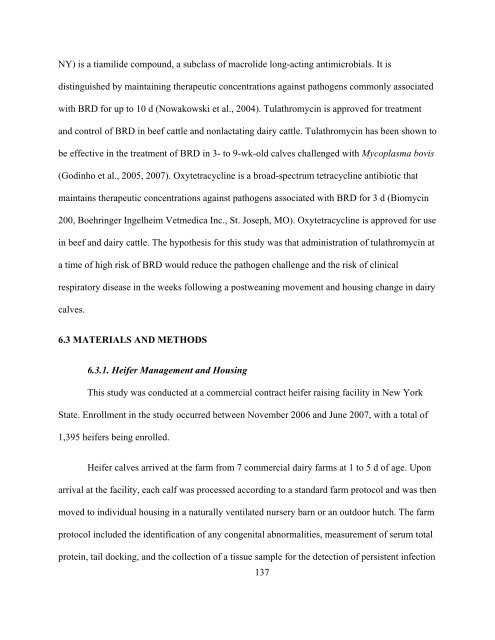Stanton PhD Thesis final_docx - Atrium - University of Guelph
Stanton PhD Thesis final_docx - Atrium - University of Guelph
Stanton PhD Thesis final_docx - Atrium - University of Guelph
You also want an ePaper? Increase the reach of your titles
YUMPU automatically turns print PDFs into web optimized ePapers that Google loves.
NY) is a tiamilide compound, a subclass <strong>of</strong> macrolide long-acting antimicrobials. It is<br />
distinguished by maintaining therapeutic concentrations against pathogens commonly associated<br />
with BRD for up to 10 d (Nowakowski et al., 2004). Tulathromycin is approved for treatment<br />
and control <strong>of</strong> BRD in beef cattle and nonlactating dairy cattle. Tulathromycin has been shown to<br />
be effective in the treatment <strong>of</strong> BRD in 3- to 9-wk-old calves challenged with Mycoplasma bovis<br />
(Godinho et al., 2005, 2007). Oxytetracycline is a broad-spectrum tetracycline antibiotic that<br />
maintains therapeutic concentrations against pathogens associated with BRD for 3 d (Biomycin<br />
200, Boehringer Ingelheim Vetmedica Inc., St. Joseph, MO). Oxytetracycline is approved for use<br />
in beef and dairy cattle. The hypothesis for this study was that administration <strong>of</strong> tulathromycin at<br />
a time <strong>of</strong> high risk <strong>of</strong> BRD would reduce the pathogen challenge and the risk <strong>of</strong> clinical<br />
respiratory disease in the weeks following a postweaning movement and housing change in dairy<br />
calves.<br />
6.3 MATERIALS AND METHODS<br />
6.3.1. Heifer Management and Housing<br />
This study was conducted at a commercial contract heifer raising facility in New York<br />
State. Enrollment in the study occurred between November 2006 and June 2007, with a total <strong>of</strong><br />
1,395 heifers being enrolled.<br />
Heifer calves arrived at the farm from 7 commercial dairy farms at 1 to 5 d <strong>of</strong> age. Upon<br />
arrival at the facility, each calf was processed according to a standard farm protocol and was then<br />
moved to individual housing in a naturally ventilated nursery barn or an outdoor hutch. The farm<br />
protocol included the identification <strong>of</strong> any congenital abnormalities, measurement <strong>of</strong> serum total<br />
protein, tail docking, and the collection <strong>of</strong> a tissue sample for the detection <strong>of</strong> persistent infection<br />
137

















